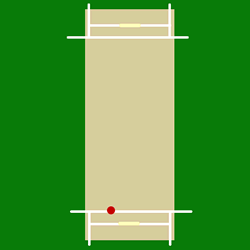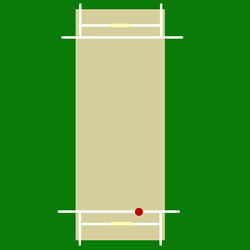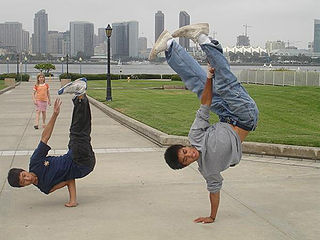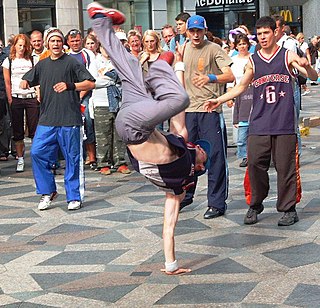
Leg spin, also called leggie, is a type of spin bowling in the sport of cricket. A leg spinner bowls right-arm with a wrist spin action, causing the ball to spin from right to left in the cricket pitch, at the point of delivery. When the ball bounces, the spin causes the ball to deviate sharply from right to left that is, away from the leg side of a right-handed batsman. The same kind of trajectory, which spins from right to left on pitching, when performed by a left-arm bowler is known as left-arm orthodox spin (ORO) bowling.

The clean and jerk is a composite of two weightlifting movements, most often performed with a barbell: the clean and the jerk. During the clean, the lifter moves the barbell from the floor to a racked position across the deltoids, without resting fully on the clavicles. During the jerk the lifter raises the barbell to a stationary position above the head, finishing with straight arms and legs, and the feet in the same plane as the torso and barbell.

A jackhammer is a pneumatic or electro-mechanical tool that combines a hammer directly with a chisel. It was invented by William Mcreavy, who then sold the patent to Charles Brady King. Hand-held jackhammers are generally powered by compressed air, but some are also powered by electric motors. Larger jackhammers, such as rig mounted hammers used on construction machinery, are usually hydraulically powered. They are typically used to break up rock, pavement, and concrete.

Balloon modelling or balloon twisting is the shaping of special modelling balloons into almost any given shape, often a balloon animal. People who create balloon animals and other twisted balloon sculptures are called Twisters, Balloon Benders and Balloon Artists. Twisters often perform in restaurants, at birthday parties, fairs and at public and private events or functions.

Breaking, also called breakdancing or b-boying/b-girling, is an athletic style of street dance. While diverse in the amount of variation available in the dance, breakdancing mainly consists of four kinds of movement: toprock, downrock, power moves and freezes. Breakdancing is typically set to songs containing drum breaks, especially in hip-hop, funk, soul music and breakbeat music, although modern trends allow for much wider varieties of music along certain ranges of tempo and beat patterns.

Wrist spin is a type of bowling in the sport of cricket. It refers to the cricket technique and specific hand movements associated with imparting a particular direction of spin to the cricket ball. The other spinning technique, usually used to spin the ball in the opposite direction, is finger spin. Wrist spin is bowled by releasing the ball from the back of the hand, so that it passes over the little finger. Done by a right-handed bowler, this imparts an anticlockwise rotation to the ball, as seen from the bowler's perspective; a left-handed wrist spinner rotates the ball clockwise.

The Windmill is a popular b-boying move. The breaker rolls his torso continuously in a circular path on the floor, across the upper chest/shoulders/back, while twirling his legs in a V-shape through the air.

The flare is an acrobatic move in which the performer alternates balancing the torso between either arm while swinging the legs beneath in continuous circles. It is a fundamental b-boying power move, and in gymnastics it may be performed on a pommel horse or during the floor exercise. The move is commonly spelled flair in gymnastics and further may be called a "Thomas flair" after its originator, Kurt Thomas.

The 6-step is the basic sequence of breakdancing footwork. The dancer uses their arms to support their body above the floor while moving their legs in a circle.
Drops are techniques that allow b-boys to transition down to the floor and begin performing downrock. Drops may be designed to look flashy, painful, or both. A wide variety of other movements can serve the same purpose, and others such as the kip-up can work in reverse, moving the breaker up from the floor.

Power moves are loosely defined as moves relying on speed, momentum, and acrobatic elements for performance. They are prominent in B-boying, often the centerpieces of routines featuring the other elements that make up breaking. Power moves are closer to gymnastics than dancing. B-boys who focus heavily on power moves and execute them as a main part of their routines are often called "power heads".

A spin is a b-boying move that involves rotation of the breaker's body about some axis in contact with the ground. It is possible to perform a spin on virtually any part of the body, but bare skin often causes painful and spin-killing friction with the floor. To solve this problem, many breakers employ pieces of cloth or wear long clothing, pads, or caps. When the dancer uses his hands to aid in speeding up the spin, it is called tapping. A dancer may tap for a few rotations and then glide for subsequent rotations. Spins form an integral part of many breakers' routines, while others eschew them in favor of more complex-looking repeated movements, back and forth, after each rotation in a given direction.

A kick is a b-boy move that generally constitutes a one-handed handstand with the legs and free arm in some stylish position. Kicks can be employed as freezes, in which case they are held as long as possible. Alternatively, they can be executed quickly and powerfully to impress onlookers. Kicks are often named after letters or symbols whose form they imitate. The hand used for the stand is the "standing hand" and the leg on the same side of the body is the "standing leg." The other pair of appendages are the "free" hand and leg.

A freeze is a b-boying technique that involves halting all body motion, often in an interesting or balance-intensive position. It is implied that the position is hit and held from motion as if freezing in motion, or into ice. Freezes often incorporate various twists and distortions of the body into stylish and often difficult positions.
A suicide is a sudden drop to a breakdancer's and B-boys back. They are frequently employed as take out moves burn moves and freeze. Ideally, suicides are very flashy and painful-looking moves. Good suicides elicit exclamations of "ouch" from onlookers and can even be comical to a certain degree. They usually end with the breaker perfectly still, enhancing the image that he has injured himself. Despite appearances, different training and techniques are used to minimize the pain of suicides. A suicide is also used to demonstrate a possible ending to a conflict that groups may have with each other.

Locking is a style of funk dance, which is today also associated with hip hop. The name is based on the concept of locking movements, which basically means freezing from a fast movement and "locking" in a certain position, holding that position for a short while and then continuing at the same speed as before. It relies on fast and distinct arm and hand movements combined with more relaxed hips and legs. The movements are generally large and exaggerated, and often very rhythmic and tightly synced with the music. Locking is performance oriented, often interacting with the audience by smiling or giving them a high five, and some moves are quite comical.
Jam skating is a combination of dance, gymnastics, and roller skating, performed on roller skates. The origins of jam skating are disputed, but it is often traced to the Great Lakes region and Florida. The style has its roots in traditional roller disco, but has been greatly influenced by breakdancing, artistic skating, gymnastics, and modern dance. Successful jam skaters are well practiced in these different forms and must have the ability to translate these movements while on skates. Jam skating first became popular in the early 1990s and is still going strong throughout the nation. Competitions, such as Heartbreak Skating Competition, Pajama Jam, Southern Slam, The Championship and Classic Summer Jam are examples of existing competitions happening. Jam Skating, like breakdancing in its early evolution, was an almost underground movement fueled by teenagers and skaters in their early 20s. Events were created to allow Jam Skaters to meet, trade moves, and, most importantly, "battle". Battling and performing remain a very important aspect of Jam Skating. This element pushes the boundaries of what is possible to perform while on skates; moreover, it ignites evolution within the skate culture.
The 2-step also known as Mini Swipe or Baby Swipe is a footwork sequence in breakdance.

The stab is a breakdance technique necessary to perform many downrock and power moves. It is not a distinct move, but is incorporated into many breakdance moves including the turtle, cricket, jackhammer, crab-walk, hand glide, some versions of the windmill, and many other floats and freezes. It allows the breakdancer's entire weight to be supported by bony structures while expending minimal muscular energy to maintain balance.
















